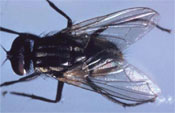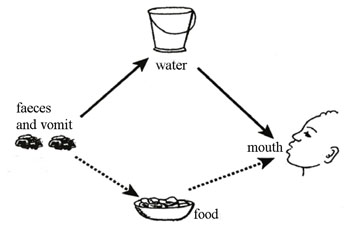33.4 Modes of transmission of diarrhoeal diseases
All three types of diarrhoeal diseases discussed so far are transmitted directly or indirectly by faeco-oral routes, as already described in detail in Study Session 32.
Briefly distinguish between direct and indirect modes of faeco-oral transmission of infectious agents.
Direct transmission occurs through contact between hands contaminated with faeces and the person’s mouth; indirect modes of transmission are through ingestion of contaminated food or water, contact with infected soil, utensils, etc., and transmission by flies that have crawled on faeces (Figure 33.4).
 Figure 33.4 Flies are a major source of indirect transmission of diarrhoeal diseases. (Photo: CDC Image Library, image 5452)
Figure 33.4 Flies are a major source of indirect transmission of diarrhoeal diseases. (Photo: CDC Image Library, image 5452)
The main modes of transmission for cholera, shigellosis and viral diarrhoeal diseases are summarised in Table 33.1 and Figure 33.5.
| Diarrhoeal disease | Main modes of transmission |
|---|---|
| Cholera | Contaminated water or food (summarised in Figure 33.5) |
| Shigellosis (bacillary dysentery) | Person-to-person contact, e.g. while caring for a sick person, or via contaminated water or food |
| Viral diarrhoeal diseases | Contaminated water or food, particularly when feeding infants with milk or other nutritious fluids in a contaminated bottle |

33.3 Rotavirus infection and other viral diarrhoeal diseases
